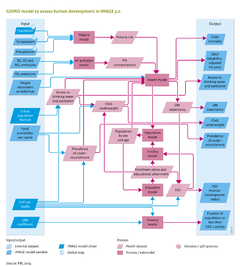Human development/Description: Difference between revisions
Jump to navigation
Jump to search
No edit summary |
No edit summary |
||
| Line 42: | Line 42: | ||
Incidence rates of diarrhoea depend on the different levels of access to drinking water and sanitation facilities, child underweight levels and also on climate change. Case fatality rates are increased by underweight levels and decreased by the level of oral rehydration therapy. | Incidence rates of diarrhoea depend on the different levels of access to drinking water and sanitation facilities, child underweight levels and also on climate change. Case fatality rates are increased by underweight levels and decreased by the level of oral rehydration therapy. | ||
(iii) Mortality associated with urban air pollution. Mortality rates of lung cancer, cardiopulmonary diseases and acute respiratory infections due to urban air pollution (i.e. PM10 and PM2.5 concentration levels) are derived by applying the GBD methodology ([[Mathers and Loncar, 2006]]). Based on the emissions of NOx, SO2 and black carbon ([[Emissions]]), PM10 concentration levels are determined using the [[Global Urban Air quality Model]] (GUAM). GUAM originates from the GMAPS model ([[Pandey et al., 2006]]), which determines PM10 concentration levels by economic activity, population, urbanisation and meteorological factors. PM2.5 concentrations are obtained using a region-specific PM10–PM2.5 ratio. Based on these concentration levels and the exposed population, mortality attributable to the aforementioned causes of death is derived using relative risks. These relative risks have been obtained from epidemiological literature ([[Dockery et al., 1993]]; [[Pope et al., 1995]]). | (iii) Mortality associated with urban air pollution. Mortality rates of lung cancer, cardiopulmonary diseases and acute respiratory infections due to urban air pollution (i.e. PM10 and PM2.5 concentration levels) are derived by applying the [[HasAcronym::GBD]] methodology ([[Mathers and Loncar, 2006]]). Based on the emissions of NOx, SO2 and black carbon ([[Emissions]]), PM10 concentration levels are determined using the [[Global Urban Air quality Model]] (GUAM). GUAM originates from the GMAPS model ([[Pandey et al., 2006]]), which determines PM10 concentration levels by economic activity, population, urbanisation and meteorological factors. PM2.5 concentrations are obtained using a region-specific PM10–PM2.5 ratio. Based on these concentration levels and the exposed population, mortality attributable to the aforementioned causes of death is derived using relative risks. These relative risks have been obtained from epidemiological literature ([[Dockery et al., 1993]]; [[Pope et al., 1995]]). | ||
== GISMO poverty model == | == GISMO poverty model == | ||
Revision as of 13:58, 16 December 2013
Parts of Human development/Description
| Component is implemented in: |
|
| Related IMAGE components |
| Projects/Applications |
| Models/Databases |
| Key publications |
| References |
